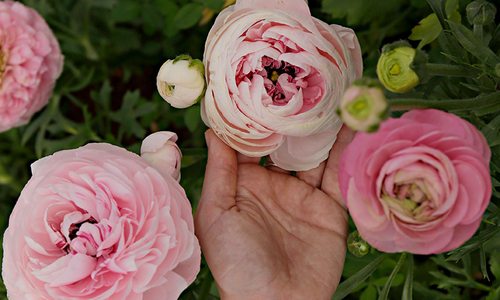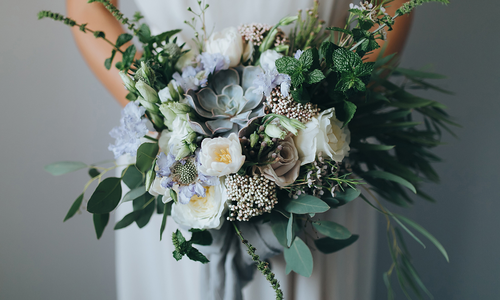Weddings
Beyond the Bloom
Using fresh flowers isn’t the only way to make a stunning bouquet on your big day. Try branching out with natural elements, fruits or jewels for a truly personal statement.
By Claire Porter | Photos by Jordan Brittley, Christine Bonnivier Photography, courtesy Linda’s Flowers
Jun 2016
Delicate succulents and pods add depth and variation
Go for Green
Swaddle your blossoms in fresh greenery and natural elements for visual interest. Bobbie Venable, bridal consultant at Linda’s Flowers, says greenery also protects delicate flowers from getting bruised and worn from handling. Charity Bennitt, owner of He Loves Me Flowers, says her favorite greens to use are eucalyptus and Italian ruscus, both of which last almost a month after cutting. Bennitt has also used fresh herbs like lavender, rosemary and chamomile for their scent, but Venable cautions brides that fresh herbs are fragile and difficult to get in bulk, so plan accordingly. Another fragile but oh-so-beautiful element to consider are succulents, which come in unusual shapes and light, dusty colors. (If you’re hesitant about using such fragile plants, consider using high-quality plastic succulents instead for all the look without the price and hassle.)
When adding height, whimsy and unusual lines, Bennitt likes to use vines and sticks for a bohemian look, and both Bennitt and Venable have worked with pinecones and evergreen sprigs for wintry weddings. But not every element has to come from the trees. Dried wheat, feathers and pods such as scabiosa pods create organic shapes and a one-of-a-kind look. “When you add those elements, they blend together so beautifully and look really unique,” Bennitt says.
Fresh (or fake!) fruit like lemons can bring an unexpected punch to centerpieces.
From the Table
Edible elements aren’t just for the dinner plate. Fruits and veggies can bring texture and depth to an arrangement. “Berries are one of my favorite elements,” Bennitt says. During the winter, there are more options for berry sprigs, but she has worked with blue privet berries for late summer weddings. Bennitt has used bigger fruits as well. She once made bouquets featuring apples and has tied asparagus into greenery for a summer wedding. For larger-scale centerpieces, lemon tree branches make a vibrant, summery addition to a table, but Bennitt notes that fruits are very fragile, perishable and heavy, especially in bouquets. To get the same look without sacrificing your arm muscles, Bennitt says artificial fruits can look realistic and are a longer-lasting substitute to fresh produce. Just be sure to work them in sparingly. “Be careful when incorporating fresh and permanent botanicals,” she says. “It can look tacky if not done carefully.”
Skip the flowers entirely for a blinged out bouquet.
Sparkle and Shine
Bouquets and boutonnieres don’t have to be all-natural, either. Couples can incorporate personal touches from their lives. For example, Venable has made boutonnieres with small light bulbs, fuses and gears for groomsmen who were machinists. “With their own choices, each aspect makes it unique to the couple,” she says. Some brides prefer a less industrial look in favor of maximum sparkle, which can be achieved by pinning tiny crystals and pearls on bouquet handles or into flower centers. If you’re really feeling the bling—or if you’re allergic to flowers, as one of Venable’s brides was—forgo flowers entirely and make a brooch bouquet. Venable pinned antique jeweled brooches the bride collected onto a silk-flower base. The result was a sparkling and sentimental bouquet that drew attention to the bride as well as any flower could.















